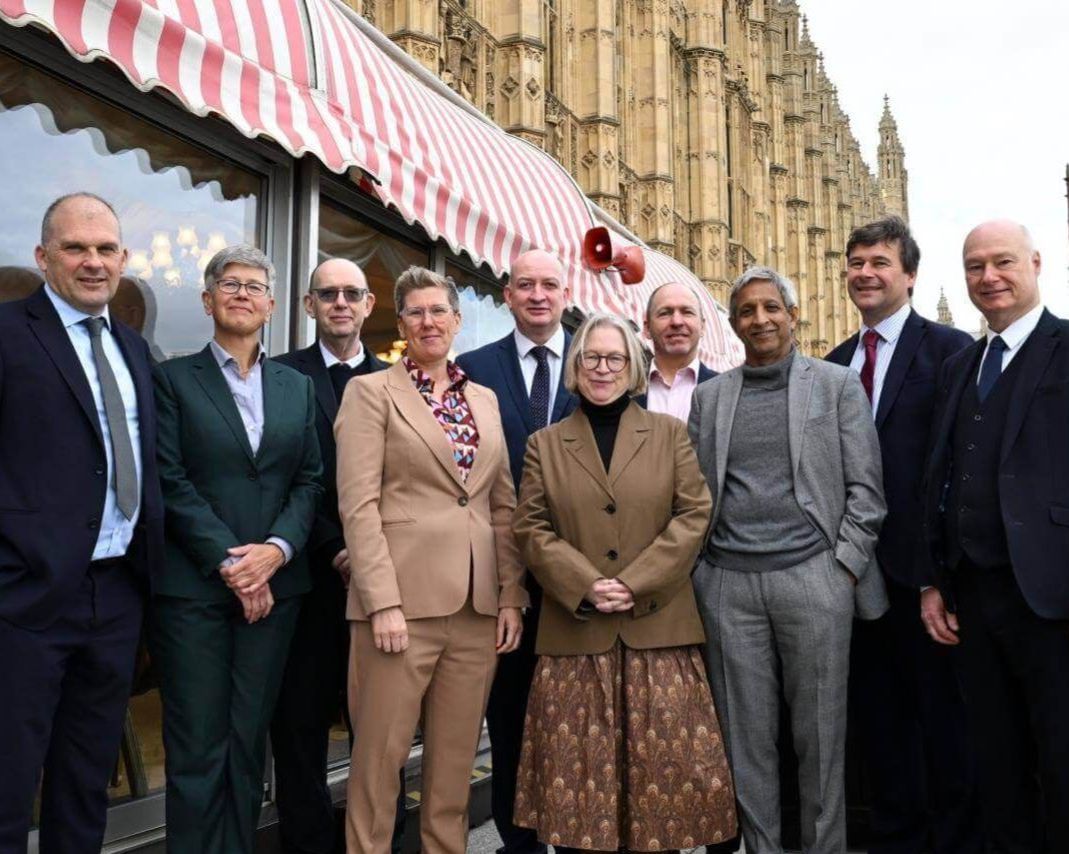How did human speech develop?
|
|
|
This email is being sent to all University of Sussex staff.
|
|
|
|
|
Wednesday 5 November 2025
|
|
|
|
Sussex helps found new collaborative of research-intensive universities |
|
|
 |
Vice-Chancellors of the 10 founding ResearchPlus universities |
|
ResearchPlus, the new collaborative of research-focused universities of which the University of Sussex is a founding partner, officially launched at a Parliamentary event in Westminster on Tuesday 28 October.
The new group will give a collective voice to research-focused universities that constitute a critical element of the UK’s research and innovation system and deliver vital research-informed education and advanced skills. |
|
|
Through shared purpose and strategic coordination, the collaborative will engage with government, industry, and civil society to support economic growth, prosperity, and societal wellbeing across the whole of the UK.
Professor Sasha Roseneil, Vice-Chancellor and President of the University of Sussex and Co-Chair of ResearchPlus, said: “I am very pleased that, after many months of discussion, a new collaborative of research-focused universities is officially launched.
“ResearchPlus is an exciting new partnership that brings together universities renowned for excellence in research and innovation, and for our positive societal impact, with the primary aim of enhancing the strength of the UK’s research and innovation base to serve the common good.
“We believe that collaboration and proactive engagement across our universities can drive the change and support the strategic coordination that is so urgently needed in the higher education and research system.”
Attendees at the House of Lords event included Vice-Chancellors from all ten ResearchPlus partners, Dr Peter Kyle MP, Secretary of State for Business and Trade, the Rt Hon. Lord Hain, Jordan Cummins, UK competitiveness director at the Confederation of British Industry (CBI) and CEO of Universities UK, Vivienne Stern MBE. |
|
|
|
Sussex study finds rare barbastelle bats at risk on our roads |
|
|
Barbastelle bats, already classed as ‘vulnerable’ in Great Britain and Europe, face a serious risk of collision with vehicles, according to new research led by the University of Sussex.
Using 3D video tracking with near-infrared cameras for the first time, researchers recorded 400 flight trajectories of bats over rural roads in West Sussex. |
|
|
More than half of flights (51%), were within five metres of the ground, placing bats in the collision zone of vehicles, particularly buses and lorries.
Dr Kieran O’Malley, the doctoral student who conducted the research, said: “Because barbastelles are already rare and breed slowly, even small increases in road deaths could have serious consequences for their populations and the wider ecosystem.”
Co-author Professor Fiona Mathews said: “Traffic is increasing year on year, presenting bats with an ever-growing risk of vehicle collisions as they swoop across our roads. This is not just an issue for new road developments; it affects all roads across the network. So, we urgently need to manage our transport infrastructure with wildlife in mind.”
The study, carried out with the Vincent Wildlife Trust and the University of Colorado, also raises concerns about widely used “hop-overs” (continuous tree canopies planted to guide bats), which may encourage crossings at unsafe heights. The researchers recommend factoring bat movement into road design and rethinking roadside vegetation management in high-activity areas.
Read the full study on barbastelle bats and road traffic risk. |
|
|
Sussex physicists share new knowledge on shape-shifting particles |
|
|
 |
NOvA Neutrino Experiment far detector at Ash River, Minnesota |
|
Sussex physicists are part of an international collaboration that has made a breakthrough in observing how neutrinos – tiny ‘ghost-like’ particles that pass through the Earth almost without detection – appear to change, or oscillate, from one type into another across space and time.
Dr Lily Asquith and her colleagues in the Sussex Neutrino Group are analysing data from the NOvA experiment in the US, where neutrinos are beamed 810 kilometres underground to a detector. Their results have been combined with Japan’s T2K experiment and published in the journal Nature.
|
|
|
Dr Asquith says: “It has been really exciting to see how these two major collaborations are helping to shed light on one of the great mysteries of existence, which is why there appears to be more matter than anti-matter in the Universe.
“The Sussex group has world-recognised expertise and leadership in neutrino research. Our work with NOvA continues with the Deep Underground Neutrino Experiment, which will give us even more information about these elusive particles.” |
|
|
Why apes do not talk – and what that reveals about us |
|
|
|
While our early human ancestors and great apes were all tool users, only humans walked upright and developed spoken language.
This evolutionary difference has long fascinated Professor Gillian Forrester, Director of the Comparative Cognition Group at the University of Sussex, who studies how communication and cognition evolve across humans and great apes.
Read the full story on ape communication |
|
|
|
Professor Winfried Hensinger commented in The Guardian on Google’s latest quantum-computing result, saying it demonstrates “quantum advantage,” while cautioning that fully fault-tolerant machines remain some way off.
Dr Darren Baskill featured in BBC Science Focus on the discovery of a new Earth-shadowing quasi-moon (2025 PN7), explaining how advances in cameras and data analysis made such a faint object detectable.
Professor Lynne Murphy featured in The Times and The Independent, commenting on why UK children increasingly use Americanisms like “trash”, “candy” and “elevator,” explaining how this reflects English’s natural, media-driven evolution.
|
|
|
|
We hope you have enjoyed this edition of Research at Sussex. We would love for you to share it with your friends, colleagues, and collaborators – so please feel free to forward it on.
Help us shape future editions. We would really value your feedback and ideas for content that you would like to see. Please send your thoughts to Campaigns@sussex.ac.uk. |
|
|
|
|
|